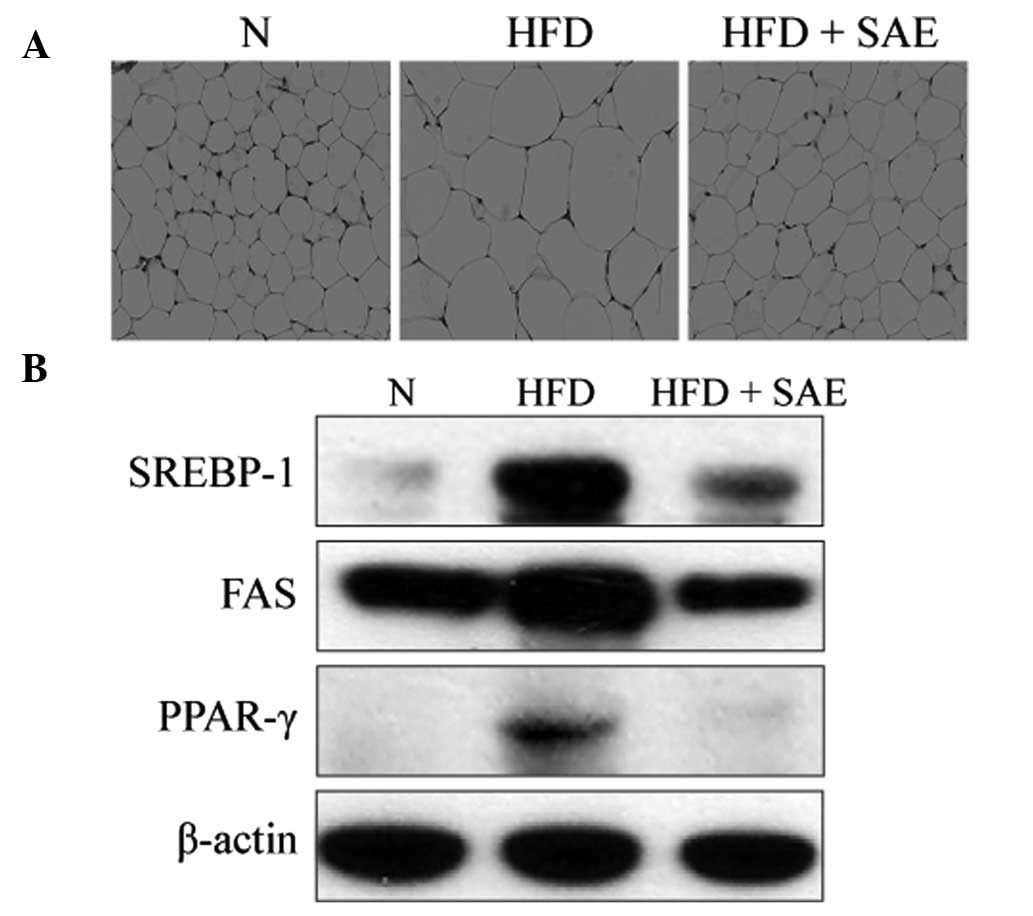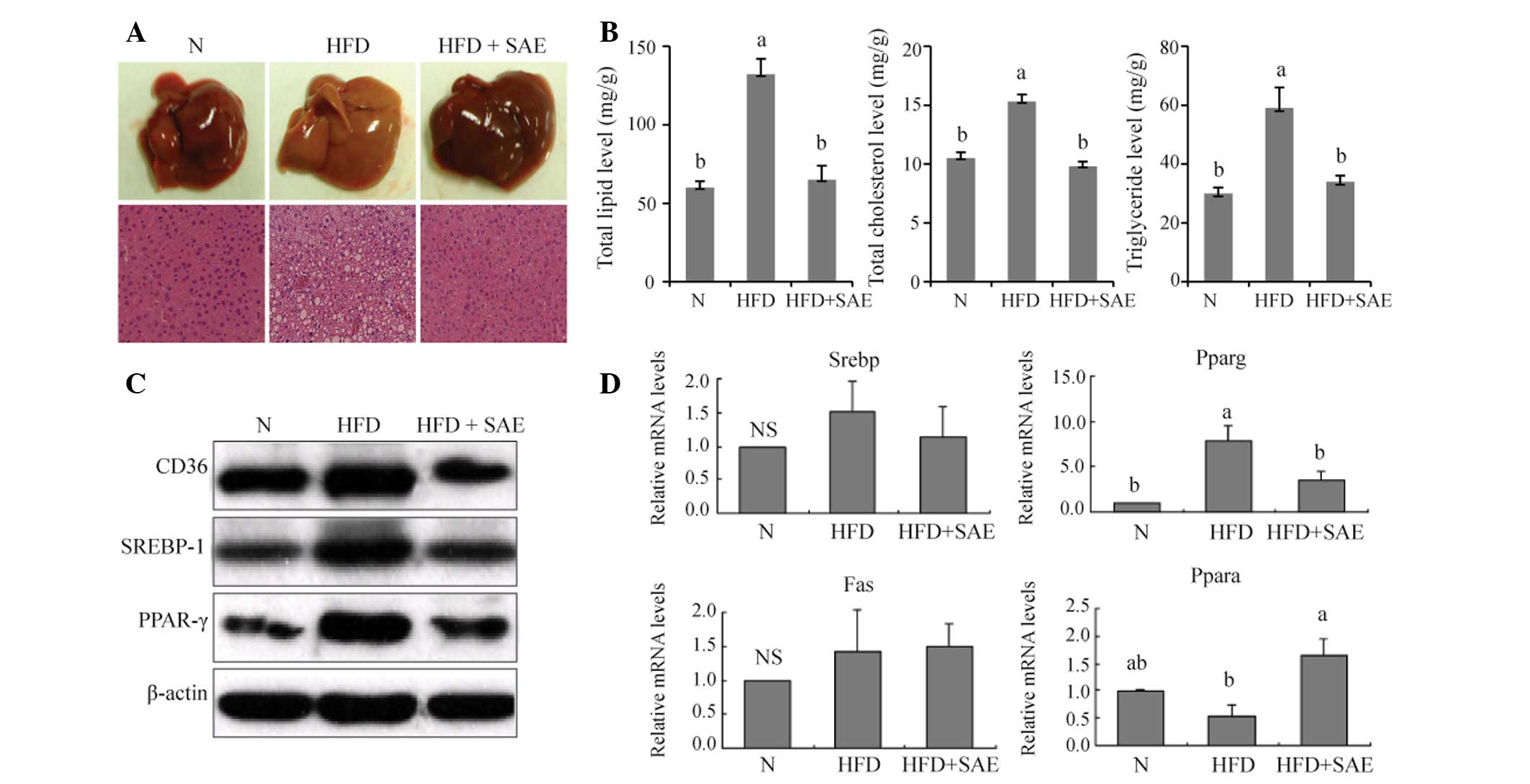Syzygium aromaticum ethanol extract reduces high‑fat diet-induced obesity in mice through downregulation of adipogenic and lipogenic gene expression
- Authors:
- Chang Hwa Jung
- Jiyun Ahn
- Tae-Il Jeon
- Tae Wan Kim
- Tae Youl Ha
-
View Affiliations
Affiliations: Division of Metabolism and Functionality Research, Korea Food Research Institute, Seongnam 463-746, Republic of Korea , Department of Food Science and Biotechnology, Andong National University, Gyeongbuk 760-749, Republic of Korea
- Published online on: June 13, 2012 https://doi.org/10.3892/etm.2012.609
-
Pages:
409-414
Metrics:
Total
Views: 0 (Spandidos Publications: | PMC Statistics:
)
Metrics:
Total PDF Downloads: 0 (Spandidos Publications: | PMC Statistics:
)
This article is mentioned in:
Abstract
Numerous medicinal plants and their derivatives have been reported to prevent obesity and related diseases. Although Syzygium aromaticum has traditionally been used as an anodyne, carminative and anthelmintic in Asian countries, its potential in the prevention and treatment of obesity has not yet been explored. Therefore, the present study investigated the anti-obesity effect of S. aromaticum ethanol extract (SAE) both in vitro and in vivo. To evaluate the anti-obesity potential of SAE in vitro, the effect of SAE treatment on adipocyte differentiation in 3T3-L1 cells was investigated. To evaluate its potential in vivo, mice were assigned to three groups: a group fed the American Institute of Nutrition AIN-76A diet (normal group), an experimental group fed a high-fat diet (HFD group) and an experimental group fed an HFD supplemented with 0.5% (w/w) SAE (HFD + SAE group). After 9 weeks of feeding, the body weight; white adipose tissue (WAT) mass; serum triglyceride (TG), total cholesterol (TC), high-density lipoprotein (HDL) cholesterol, glucose, insulin and leptin; hepatic lipid accumulation; and levels of lipid metabolism-related genes in the liver and WAT were measured. In vitro investigation of the effect of SAE treatment on 3T3-L1 cells revealed that it had efficiently inhibited the conversion of cells into adipocytes in a dose-dependent manner. In vivo investigation revealed that SAE supplementation had significantly decreased HFD-induced increases in the body weight, liver weight, WAT mass, and serum TG, TC, lipid, glucose, insulin and leptin levels. Consistent with its effects on liver weight and WAT mass, SAE supplementation was found to have suppressed the expression of lipid metabolism-related proteins, including SREBP-1, FAS, CD36 and PPARγ in the liver and WAT, in addition to downregulating mRNA levels of transcription factors including Srebp and Pparg. SAE inhibits fat accumulation in HFD-fed mice via the suppression of transcription factors integral to adipogenesis and lipogenesis, suggesting its potential in preventing obesity.
View References
|
1.
|
World Health Organization: Fact sheet No.
311: obesity and overweight. http://www.who.int/mediacentre/factsheets/fs311/en/index.htmluri.
May 2012.
|
|
2.
|
Hasani-Ranjbar S, Nayebi N, Larijani B and
Abdollahi M: A systematic review of the efficacy and safety of
herbal medicines used in the treatment of obesity. World J
Gastroenterol. 15:3073–3085. 2009. View Article : Google Scholar : PubMed/NCBI
|
|
3.
|
Yin J, Zhang H and Ye J: Traditional
Chinese medicine in treatment of metabolic syndrome. Endocr Metab
Immune Disord Drug Targets. 8:99–111. 2008. View Article : Google Scholar : PubMed/NCBI
|
|
4.
|
Gurib-Fakim A: Medicinal plants:
traditions of yesterday and drugs of tomorrow. Mol Aspects Med.
27:1–93. 2006. View Article : Google Scholar : PubMed/NCBI
|
|
5.
|
Chaieb K, Hajlaoui H, Zmantar T,
Kahla-Nakbi AB, Rouabhia M, Mahdouani K and Bakhrouf A: The
chemical composition and biological activity of clove essential
oil, Eugenia caryophyllata (Syzigium aromaticum L.
Myrtaceae): a short review. Phytother Res. 21:501–506. 2007.
View Article : Google Scholar : PubMed/NCBI
|
|
6.
|
Das S: Anticancer potential of flavouring
agents and their active principles – garlic, saffron, clove. Int J
Cancer Prev. 1:89–97. 2004.
|
|
7.
|
Abdel-Wahhab MA and Aly SE: Antioxidant
property of Nigella sativa (black cumin) and Syzygium
aromaticum (clove) in rats during aflatoxicosis. J Appl
Toxicol. 25:218–223. 2005.
|
|
8.
|
Fu Y, Zu Y, Chen L, Shi X, Wang Z, Sun S
and Efferth T: Antimicrobial activity of clove and rosemary
essential oils alone and in combination. Phytother Res. 21:989–994.
2007. View
Article : Google Scholar : PubMed/NCBI
|
|
9.
|
Park MJ, Gwak KS, Yang I, Choi WS, Jo HJ,
Chang JW, Jeung EB and Choi IG: Antifungal activities of the
essential oils in Syzygium aromaticum (L.) Merr. Et Perry
and Leptospermum petersonii Bailey and their constituents
against various dermatophytes. J Microbiol. 45:460–465.
2007.PubMed/NCBI
|
|
10.
|
Tanko Y, Mohammed A, Okasha MA, Umar AH
and Magaji RA: Anti-nociceptive and anti-inflammatory activities of
ethanol extract of Syzygium aromaticum flower bud in Wistar
rats and mice. Afr J Tradit Complement Altern Med. 5:209–212.
2008.PubMed/NCBI
|
|
11.
|
Kuroda M, Mimaki Y, Ohtomo T, Yamada J,
Nishiyama T, Mae T, Kishida H and Kawada T: Hypoglycemic effects of
clove (Syzygium aromaticum flower buds) on genetically
diabetic KK-Ay mice and identification of the active ingredients. J
Nat Med. 66:394–399. 2012.
|
|
12.
|
Madsen L, Petersen RK, Sørensen MB,
Jørgensen C, Hallenborg P, Pridal L, Fleckner J, Amri EZ, Krieg P,
Furstenberger G, et al: Adipocyte differentiation of 3T3-L1
preadipocytes is dependent on lipoxygenase activity during the
initial stages of the differentiation process. Biochem J.
375:539–549. 2003. View Article : Google Scholar : PubMed/NCBI
|
|
13.
|
Dube MG, Beretta E, Dhillon H, Ueno N,
Kalra PS and Kalra SP: Central leptin gene therapy blocks high-fat
diet-induced weight gain, hyperleptinemia, and hyperinsulinemia:
increase in serum ghrelin levels. Diabetes. 51:1729–1736. 2002.
View Article : Google Scholar : PubMed/NCBI
|















